
Getting into big walling is not necessarily easy. Between acquiring all the necessary equipment, learning, as well as practising the technical skills and finding an appropriate goal, there's a lot to figure out before you'll be ready to rope solo El Cap or climb the Dawn Wall. Although the best place to learn is arguably in Yosemite itself, if you don't have the time or money to commit to a trip to California just yet, there are a few options a little closer to home. One of these is the 800m East Face of Monte Qualido above Val di Mello in Italy.
The Area
I previously wrote about the climbing here as part of another destination article. This was focused on the bouldering, sport climbing and one day multi-pitch climbing available in the valley. When it comes to big multi-pitches, these are mainly on the North side of Val di Mello itself, and are usually a dozen pitches long or fewer. These are normally climbed in a day, including the approach from the valley.
Higher up, just below the region's summits (Zocca, Badile, Cengalo, Cavalcorto, etc.), are also a multitude of alpine rock routes. Again, most of these are 12 pitches or less and are climbed in a day, with an extra day for the approach and a night in a refuge. Most of these summits lie on the border with Switzerland.
Between these alpine routes and the lower valley climbs is Monte Qualido, which on its East side is up to 800m high. The routes there are up to 20 pitches long, putting it at the limit of what can be done in a day. The highest point, on top of the "Martello del Qualido", is at an altitude of 2707 metres.
The Climbing
Talking of tactics and Monte Qualido, the question of what makes a route a big wall quickly comes up. Most of the routes on it get a route length grade of IV. A quick glance at Wikipedia will tell us this indicates "A multipitch route at higher altitude or remote location, which may involve multi-hour approaches in serious alpine terrain. A predawn start is usually indicated, and unforeseen delays can lead to unplanned bivouacs high on the route". For information, The Nose on El Cap is a VI, meaning it takes several days for a normal party to climb it.
Routes on Monte Qualido, particularly on its right-hand side, are mostly between 600 and 800m long. The routes tend to include a lot of free climbing and although most routes traditionally require some aid, almost all of it is A0 or A1, occasionally A2. The approach from the valley can take around 1.5 to 2hrs, a lot of it uphill, though this will be for a fit team who knows where they're going. It can easily take double that with a few mistakes. Given these facts, locals and people who know the area (quite a few mountain guides live close by) will often do these routes in a day, moving fast and "French-freeing" when necessary. That being said, it is common for the routes to be done big-wall style instead, either because the climbers are trying to free a route, because they don't have the skills to move that fast, or just because they want to enjoy the time spent on the wall. For that matter, several of the climbs were put up this way in the first place.
The rock is granite, mostly of great quality, though of course with a wall of this size loose blocs are to be expected occasionally, and rockfall has been reported in some years (it's useful to get in touch with local climbers prior to making the approach – Bar Monica being the obvious place to start). Most of the wall is fairly easy angled, meaning that on top of the usual granite cracks, flakes and dihedrals, technical blank slabs feature prominently.
The gear is a mix of trad and bolts, though obviously you can't expect a Kalymnos single pitch style concentration of bolts. A slab pitch of 40-50m with no trad placements will typically have 6 or 7 bolts, usually just before a hard move or hard sequence. Luckily, as the usual descent is via abseil on the routes, many belays are equipped with 8mm or 10mm stainless steel bolts, and the bolts in the routes are normally 8mm.
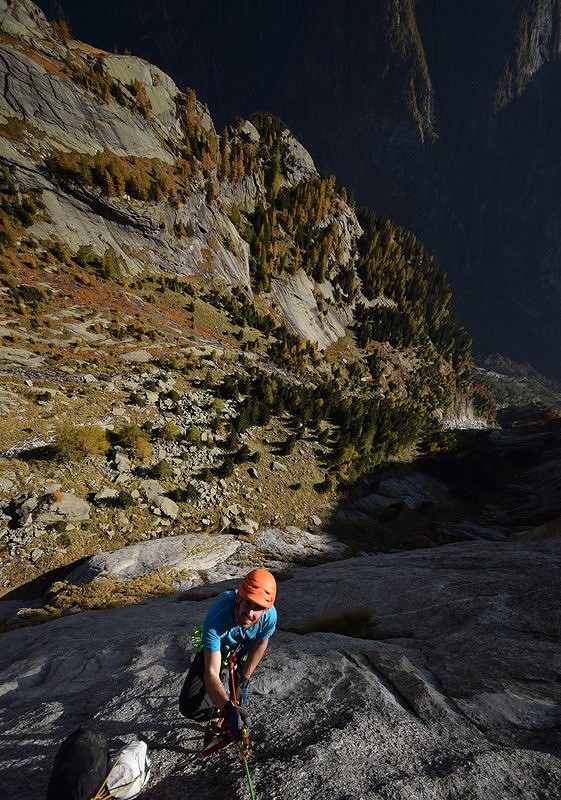
Brief History
The first route up the face was Paolo Fabbri 43 (7a), climbed in 1978 by Paolo Masa and Jacopo Merizzi. This route is up the shorter left hand side of the face, and is therefore "only" 485m long.
A few years later, in 1982, Antonio Boscacci joined Paolo Masa and Jacopo Merizzi to open the first route up the main part of the face, Il Paradiso Puo Attendere (7b) (6b/A2 or 7b free), which uses a system of ledges at the top to reach an easier corner system, making the original route around 950m long.
After a few years of relative calm, the 1990s saw most of the obvious lines get climbed by a group of dedicated climbers, a lot of which were first climbed using big wall tactics. Artemisia (7a)(6b/A1 or 7b free) and Melat (7b+) (6b/A2 or 7b with only 7 points of aid) were both climbed in 1993 and are considered today to be two of the easiest and nicest lines up the face.
The late 1990s saw the arrival of one Simone Pedeferri, a young climber at the time, who started opening his own lines on the wall, such as Magic Line (7b+) (6b/A1 or 7b+ free), which he opened in 1995 with Barbara Guattini, Stefano Pizzagalli, Domenico Soldarini and Marco Vago.
Over the next 15 years, Simone Pedeferri would open a number of new lines, but also free climb most of the existing lines, putting up pitches of up to 8b. In 2004 he put up over three separate days 'Joy Division' (800m, 8b), a line which combined some of the hardest pitches on the existing lines and linked them via further hard pitches, making it possibly the hardest line up the face.
'Joy Division' saw its second, and first one-push ascent, 7 years later, when James Pearson spent 15 days working it over 3 months, to finally climb it in one, clean, two-day ascent:
Logistics
Once you enter the Val Masino valley (of which Val di Mello is an off shoot), options for food and gear diminish greatly. There are a few very small food shops that sell a handful of overpriced goods. There is also one climbing shop, Fiorelli Sport, but the owner keeps irregular opening hours, mainly opening at weekends (When we asked local climbers when Fiorelli would be open, they answered with a smile "When he wants!"). A better option for your food and gear needs is to head back out of the valley and either East to Sondrio or West to Morbegno (a town apparently twinned with Llanberis). Just before you reach Sondrio there is a major shopping area with supermarkets (Lidl, Iperal) and outdoor shops (Decathlon, Crazy). In Morbegno there is another Iperal and another Crazy.
For information about the routes, 'Versante Sud' have included Monte Qualido in both their 'Val di Mello' and 'Solo Granito' guidebooks. The former is best if you are interested in the shorter classics in the valley, the latter if you want to explore the routes in the higher areas. Another option is 'Nel Regno del Granito' from Alpine Studio, which also covers a wide area, with some more precise topos at times. Regardless of whether you choose to acquire one of the guidebooks, the website by Paolo Vitali and Sonja Brambati, two climbers having put up their own first ascents on Qualido in the 90s, is a brilliant source of information. Their detailed pdf topos of each route are extremely accurate (they even record the locations of specific points of aid) and great to print and laminate. Unfortunately most of the website is in Italian, but Google Translate is here to help!
Finally, dropping by Bar Monica for some extra information is a great idea. Most guidebooks are available to look up there (some of which with hand written added information, grade corrections, gear, new lines, etc.), and local and visiting climbers can help you with some additional information. If you're lucky, Simone himself might give you some extra hints. It's worth noting that some of the staff in the Crazy shops are also climbers and/or guides, so if you stop there don't hesitate to ask about routes.
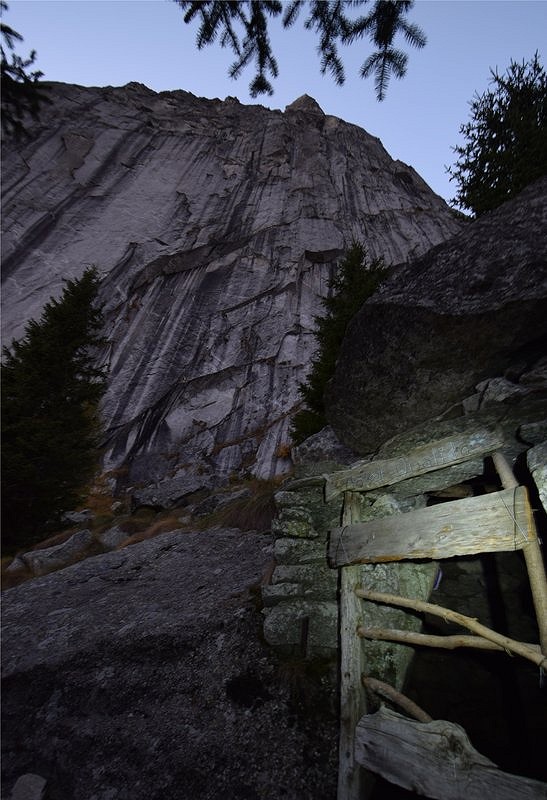
Approach & bivy
On the day, if you've driven in, a few options are available for parking, but the best is probably to park in the sports ground car park at San Martino (drive into San Martino and follow the parking signs going right through and out of town. Make sure you don't park in the spaces used for the market on Mondays if you're likely to be there on that day). This is the closest free parking to Val di Mello. Paying alternatives are in San Martino or at the start of Val di Mello itself (expensive and only accessible part of the year). Of course, if you're staying in the Sasso Remenno campsite, leaving your car there will only add around 10min to your walk-in.
From there follow the signs up into Val di Mello, eventually reaching the end of the road and continuing on the valley path along the river. When you reach 'Agroturismo Ca' dei Scuma' (across the river), turn left up the valley side. The path is marked from then on with red and white paint. Follow it until you're right beneath the routes on the far end of Monte Qualido's East Face, then leave the main path and cross over to the bottom of the routes. If it takes you more than 10min once you leave the marked path, you've gone wrong. There are a number of big boulders which are suitable for bivying, though only one is the historic "Hotel Qualido", a shelter once used by shepherds before being repurposed for climbers and even fitted with a chimney. This particular shelter is unmistakable, being the only one fitted with a door with its name on it. It's between a few trees on the edge of the forest. There is plenty of running water available around the area to fill your bottles, so consider only bringing water for the approach to save weight.
The Climb
As previously mentioned, most routes use a mix of traditional protection and bolts. Anchors tend to be bolted, especially if the route is a line of descent as well. A set of cams and nuts should be enough to get you up most routes. Doubling up is usually not necessary, though carrying a wider set, particularly of cams, can be crucial on some routes, particularly micro cams and/or offset cams for thinner pitches. Offset cams are remarkably well suited to some of the uneven cracks you find on this wall. The odd pitch may also require a large cam (sometimes BD4 or BD5), but the guidebooks normally specify it. Once again asking around about gear and routes will yield useful information. If you plan to aid quite a few sections it can also be worth checking how bolted the pitches are to know if extra gear might be needed, though heavy aid is not common on Qualido.
Finally, take into account the time needed to abseil the 20 odd pitches (probably around 2hrs without any major epics – it can get windy). Some parties spend another night at the base of the wall, though the descent is likely to take less time than the walk in, possibly because of the knowledge that a return to San Martino can only mean one thing – fresh beer at Bar Monica!
Practice options
Learning big walling techniques can be tricky, and finding someone to show you the basics is almost a requirement. That being said, there are a few resources available to help you learn what you need. Chris McNamara's book 'How to Big Wall Climb', as well as his Youtube videos, are an extremely useful source of information, as is the ebook 'High: Advanced Multipitch Climbing' by David Coley and Andy Kirkpatrick, with the associated website.
Most people like to practise their skills back at home to fly out ready to go, but you may want to add in some final practice in the valley itself. Luckily, there are a few options. The Sasso Remenno boulder, near the campsite of the same name, provides some fully bolted aid practice lines on its roadside, as well as some two pitch slabs on the back which make decent hauling and jumaring training terrain. The surrounding sport lines can also give a good introduction to granite slabs. If you have the time, getting familiar with the valley by doing some of the classic one-day multi-pitches such as Il Risveglio di Kundalini (6a+),Luna Nascente (6b) or No match for climb id:38182,"Oceano Irrazionale" is a great way of discovering the climbing style and approaches.
Many of these points are covered in the destination guide to Val di Mello, so this is meant more as a summary.
Logistics
When to Go
For a change, Spring and Autumn!
How to Get There
Fly to Milan, Train to Morbegno, Bus to San Martino
Fly to Milan, rent a car
Drive down through France/Belgium/Germany/Switzerland/Italy (can actually be cost effective given the amount of gear needed)
Accommodation Advertise here
No Premier Listings found in this area
Hotels in San Martino, Sasso Remenno Campsite, Campsite in Val di Mello (expensive with a car).
What's the food like?
Good! The shops are limited and expensive in San Martino. There are lots of options down between Morbegno and Sondrio (20-30min drive down and out of the valley).
Outdoor Shops Advertise here
No Premier Listings found in this area
Guidebook
by Paolo Vitali and Sonja Brambati
Nel Regno del Granito - Andrea Gaddi (2014)
Val di Mello - Versante Sud (2014) – Covers only Val di Mello but offers more on the short end of the spectrum (single pitches and short multi-pitches)
Solo granito 1 - Versante Sud (2014) – Covers a wider area, including Val di Mello, but focused on bigger days out.
Instructor/Guides Advertise here
No Premier Listings found in this area
- DESTINATION GUIDE: Albarracin: Spanish Sandstone Bouldering 25 Jul, 2019
- DESTINATION GUIDE: Targassonne Bouldering 25 Jun, 2017
- DESTINATION GUIDE: Val Masino / Val di Mello 22 Jun, 2017

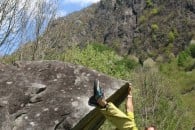





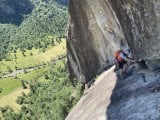


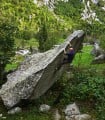

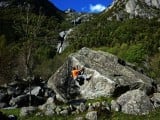
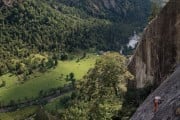


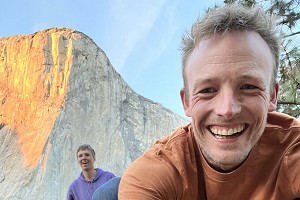






Comments
A short video we made about climbing 'Medditeraneo', one of the lines on Monte Qualido:
https://youtu.be/03iWxFeZGmA?list=PL4fMezoPrDdE8sC0c387rz6GVc8lrHriJ